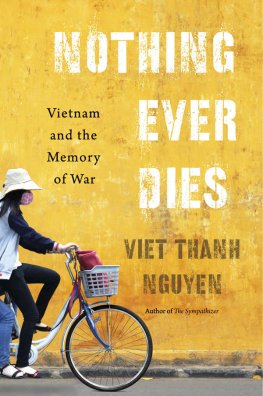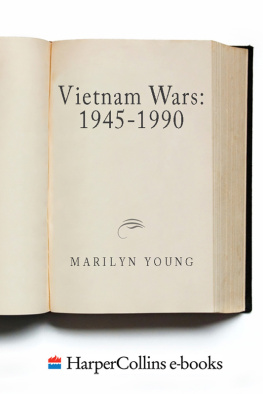A mericas W ars
in A sia
A Study of the Maureen and Mike Mansfield Foundation
A mericas W ars
in A sia
A Cultural Approach
to History and Memory
| Edited by |
| Philip West |
| Steven I. Levine |
| Jackie Hiltz |
First published 1998 by M.E. Sharpe
Published 2015 by Routledge
2 Park Square, Milton Park, Abingdon, Oxon OX14 4RN
711 Third Avenue, New York, NY 10017, USA
Routledge is an imprint of the Taylor & Francis Group, an informa business
Copyright 1998 Taylor & Francis. All rights reserved.
No part of this book may be reprinted or reproduced or utilised in any form or by any electronic, mechanical, or other means, now known or hereafter invented, including photocopying and recording, or in any information storage or retrieval system, without permission in writing from the publishers.
Notices
No responsibility is assumed by the publisher for any injury and/or damage to persons or property as a matter of products liability, negligence or otherwise, or from any use of operation of any methods, products, instructions or ideas contained in the material herein.
Practitioners and researchers must always rely on their own experience and knowledge in evaluating and using any information, methods, compounds, or experiments described herein. In using such information or methods they should be mindful of their own safety and the safety of others, including parties for whom they have a professional responsibility.
Product or corporate names may be trademarks or registered trademarks, and are used only for identification and explanation without intent to infringe.
Library or Congress Cataloging-in-Publication Data
Americas wars in Asia: a cultural approach to history and memory / edited by Philip West, Steven I. Levine, and Jackie Hiltz.
p. cm.
An East gate book
Includes bibliographical references and index.
ISBN 0-7656-0236-9 (hardcover: alk. paper).
ISBN 0-7656-0237-7 (paperback: alk. paper)
1. AsiaHistory20th century. 2. United StatesHistory, Military20th century. 3. AsiaMilitary relationsUnited States. 4. United StatesMilitary relationsAsia. 5. War and societyUnited StatesHistory20th century. 6. War and societyAsiaHistory20th century. 7. MemorySocial aspects-United States. 8. MemorySocial aspectsAsia. I. West, Philip, 1938II. Levine, Steven I. III. Hiltz, Jackie.
DS35.A55 1997
950.4dc21 97-27652
CIP
ISBN 13: 9780765602374 (pbk)
ISBN 13: 9780765602367 (hbk)
Contents
Philip West, Steven I. Levine, and Jackie Hiltz
Edward T. Linenthal
John W. Dower
Tadao Sato
David R. McCann
Leslie Kennedy Adams
James Soular
Van Jay Symons
Merrel Clubb
Ahn Junghyo
Colonel Harry Summers, Jr.
Pingchao Zhu
James Z. Gao
Rey Chow
Kentaro Awaya
John Ernst
G.L. Penrose
David Trask
This is a book about war. More precisely, it is about three wars the United States fought in Asia between 1941 and 1975: the Pacific War, the Korean War, and the Vietnam War. It is not a book about military strategy and tactics or campaigns and battles, nor does it focus on the politics and diplomacy of war. In the broadest sense its subject matter is the human dimensions of war as experienced by those who fought in, lived through, and later remembered these wars. It is an exercise in history and memory.
The book is one of the fruits of a 1995 Summer Institute held at The University of Montanas Maureen and Mike Mansfield Center.* Since 1984 the work of the Center has been supported primarily by the Maureen and Mike Mansfield Foundation. The Institute itself was funded by the National Endowment for the Humanities. It brought together twenty-two American and three Chinese college professors from around the country for an intensive study of the United States and Asia at war. We employed a cultural approach that is explained in the Introduction. Over a six-week period, we studied these wars with the help of presentations by historians, authors, filmmakers, film critics, and literary specialists from East Asia and the United States as well as war veterans and others. We read many American and Asian novels, short stories, and poems, and viewed dozens of American and Asian feature films, documentaries, and television series that dealt with the wars. In animated discussions that sometimes turned rancorous and even confrontational, we grappled with one another, deepening our appreciation of the multiple meanings of these wars. As we deployed our varying disciplinary approaches, our positions were constantly under fire from colleagues who sharply, and sometimes painfully, challenged our assumptions, preconceptions, and accustomed modes of understanding. Our understanding of the United States and Asia at war was both complicated and clarified by this process. Now, through this book, we would like to share our experience.
The purpose of this multiauthored volume is to encourage others, particularly teachers and students, to develop an understanding of the experience of war in Asia that is variegated, fragmented, and often contradictory. For us the image of a tangled web best conveys the multiple meanings of the wartime experiences. Like all good teaching, ours is an openended, ongoing project. We hope that readers will respond in the same spirit, using this volume not as a terminus but as a point of departure for their own explorations of the subject of the United States and Asia at war.
* * *
Note: John Dower has placed the surname first while the other authors place the surname last.
Philip West
Steven I. Levine
Jackie Hiltz
Missoula, Montana, March 1997
_______________
*We would especially like to acknowledge the cheerful and able assistance of Cathy Brown and Susan Gibb in the planning and administration of the National Endowment for the Humanities Summer Institute. Because of their hard work, the Institute proceeded smoothly and pleasantly.
A mericas W ars
in A sia
Philip West, Steven I. Levine, and Jackie Hiltz
Up behind the front lines a bird used to chirp
its mating call at sundown for several days.
And his call was answered from amidst the
desolation. It was beautiful, a sign maybe
that there still remained a God somewhere.
Only one evening there was no answering chirp.
Merrel Clubb
Iwo Jima, March 1945
Relations between the United States and Asia are increasingly economic in nature, but it was not always so. As veteran Asia hand Frank Gibney writes, For many of us it began in war.1 Less than five years after the end of the Pacific War in August 1945, the United States intervened in a new war that erupted in Korea in June 1950. By the time that war sputtered out in July 1953, Washington had already embarked upon its fateful involvement in Vietnam that would drag on until April 1975. For three generations of American men and women who served in the armed forces, and for everyone on the home front who listened to the radio, watched newsreels and television, and anxiously scanned newspaper headlines, Asia was a battlefield long before it became a marketplace. For hundreds of millions of Japanese, Koreans, Chinese, and Vietnamese, the United States was either an enemy or an ally. The American soldier, dispenser of bullets and Hershey bars, napalm and chewing gum, was the ambiguous symbol of American culture and civilization.











